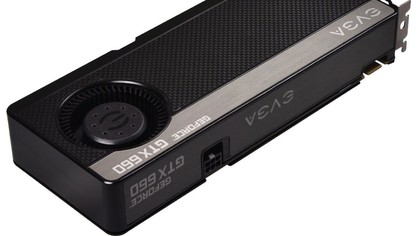TechRadar Verdict
Pros
- +
Affordable price
- +
Runs quietly
- +
SLI and 3D support
Cons
- -
Doesn't blow 500-series away
Why you can trust TechRadar
Ever since Nvidia debuted its new Kepler architecture with the GeForce GTX 690 and the GeForce GTX 680, the GPU mogul has been working its way down the price point tree. At $1,000 and $500, prices ranged from jaw dropping to still pretty unaffordable. The GeForce GTX 670 came next, but at $400, it was still above the reach of the average gamer's wallet.
When the Geforce GTX 660Ti hit shelves last month at $300, pricing for Nvidia's new Kepler cards finally hit a sweet spot of affordability and graphical horsepower. Now the fashionably late Geforce GTX 660 has arrived, with a release date of Sept. 13 and $229 price tag, how does this latecomer stack up against the earlier arrivals in terms of power versus price?
The Geforce GTX 660 may be the most affordable member of Nvidia's 600-series, but it's still packing serious hardware. It has 2GB of memory, just like its bigger brothers, and has 960 CUDA cores spread across five SMX units, which is not a big step down from the 1,344 found in the 660Ti, considering the price.
It's a card designed to run the latest shooters and RPG adventures at a crisp 1080p HD resolution like 1920x1080 or 1920x1200 at reliable frame rates. The 2560x1600 resolution, which looks so awesome on mammoth displays, will remain out of your reach, at least with a single 660 in your rig (the 660 is SLI ready).
In hard numbers, the 660 hasn't been chopped down much from the 670. Just like the 660Ti, it sports 24 ROPs, a 384KB L2 Cache, a 192-bit memory interface and 144.2 GB/s of total memory bandwidth. Console gamers may have to wait a bit for the next generation of gaming to hit their television, but for PC gamers, it's here.

EVGA Superclocked
In addition to SLI capabilities, the GTX 660 can be overclocked, and EVGA has done so, releasing a card with a base clock of 1046 Mhz, and a boost clock of 1111Mhz. If you're nervous about overclocking a card and voiding your warranty, a card that's already cranked up right out of the box should help your nerves.
Better yet, EVGA backs its work with a three-year warranty, which can be upgraded to 10 years if you register and drop a $30 fee. Basically, there's no reason to worry that the tweaking they've done will end up burning your card and your bank account.
Sign up for breaking news, reviews, opinion, top tech deals, and more.